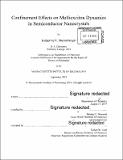| dc.contributor.advisor | Moungi G. Bawendi. | en_US |
| dc.contributor.author | Shulenberger, Katherine E.(Katherine Emily) | en_US |
| dc.contributor.other | Massachusetts Institute of Technology. Department of Chemistry. | en_US |
| dc.date.accessioned | 2020-03-09T18:51:17Z | |
| dc.date.available | 2020-03-09T18:51:17Z | |
| dc.date.copyright | 2019 | en_US |
| dc.date.issued | 2019 | en_US |
| dc.identifier.uri | https://hdl.handle.net/1721.1/124053 | |
| dc.description | Thesis: Ph. D., Massachusetts Institute of Technology, Department of Chemistry, 2019 | en_US |
| dc.description | Cataloged from PDF version of thesis. | en_US |
| dc.description | Includes bibliographical references (pages 125-135). | en_US |
| dc.description.abstract | Colloidal semiconductor nanocrystals are a promising platform for a number of technological developments in a wide variety of lighting applications. They also are an incredibly useful model system to interrogate fundamental carrier interactions in crystalline semiconductor lattices. This thesis investigates the properties of multiexciton states in semiconductor nanocrystals to build an understanding of what drives their emission dynamics and efficiency. A complete understanding of the processes which dominate in a wide variety of nanocrystal systems sheds light on electron-hole and exciton-exciton interactions and provides guidance on how to engineer nanocrystals for particular applications. In the first two chapters, I will build a foundation of understanding of semiconductor nanocrystal systems, and how to build up an intuitive understanding of the states in question from both fundamental modeling and chemical intuition. | en_US |
| dc.description.abstract | I also present a variety of methods which are used to interrogate the luminescent properties of these materials, with a particular focus on those utilized in this thesis. In the second chapter in particular, I focus on how photoluminescence measurements can go astray, how to identify artifacts or background signal which could bias or invalidate data, and how to eliminate these artifacts. The next chapter details the biexciton and triexciton emission dynamics and efficiency in CdSe nanocrystals. Utilizing a well-established and well-studied semiconductor systems allows nuanced interpretation of the emission dynamics, and the identification of perhaps some unexpected material properties to enhance how we imagine these highly excited states. Chapter four employs a suite of methods to begin to understand carrier-carrier interactions in cesium lead halide perovskite nanocrystals. | en_US |
| dc.description.abstract | This system provides a particularly interesting platform to investigate the effect of confinement and lattice mobility on excitonic properties. Finally, I present a few experimental directions and ideas which have not yet been explored and would provide an excellent continuation of this work. | en_US |
| dc.description.statementofresponsibility | by Katherine E. Shulenberger. | en_US |
| dc.format.extent | 135 pages | en_US |
| dc.language.iso | eng | en_US |
| dc.publisher | Massachusetts Institute of Technology | en_US |
| dc.rights | MIT theses are protected by copyright. They may be viewed, downloaded, or printed from this source but further reproduction or distribution in any format is prohibited without written permission. | en_US |
| dc.rights.uri | http://dspace.mit.edu/handle/1721.1/7582 | en_US |
| dc.subject | Chemistry. | en_US |
| dc.title | Confinement effects on multiexciton dynamics in semiconductor nanocrystals | en_US |
| dc.type | Thesis | en_US |
| dc.description.degree | Ph. D. | en_US |
| dc.contributor.department | Massachusetts Institute of Technology. Department of Chemistry | en_US |
| dc.identifier.oclc | 1142099499 | en_US |
| dc.description.collection | Ph.D. Massachusetts Institute of Technology, Department of Chemistry | en_US |
| dspace.imported | 2020-03-09T18:51:16Z | en_US |
| mit.thesis.degree | Doctoral | en_US |
| mit.thesis.department | Chem | en_US |
